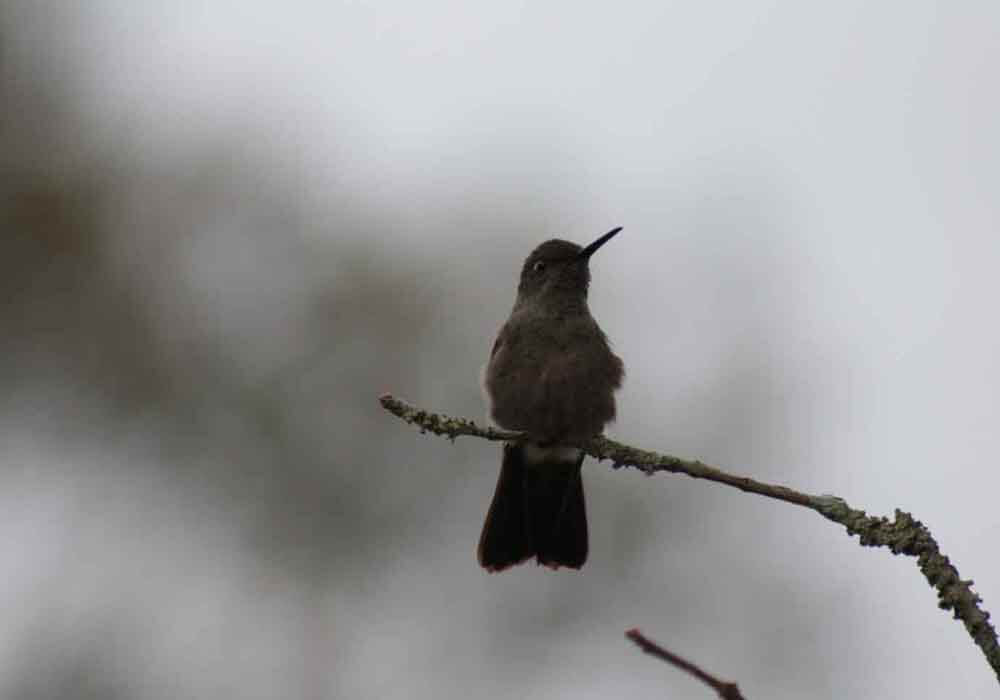What Do Hummingbirds Eat
in the Winter?
Hummingbirds aren’t readily seen in the winter months, as they are tropical birds native to areas of South America. However, some hummingbirds are occasionally found flying around in colder months after the nectar-producing flowers of summer are long gone. This may leave you wondering what hummingbirds eat in the winter.
Hummingbirds eat insects in the winter for their protein, yet they also still eat nectar for their energy. Nectar is often scarce in winter months, though some hummingbirds may source it from winter-blooming plants and nectar feeders installed by the locals.
In this article, I’ll explain more about what hummingbirds eat in the winter and why you may see them during this season. I’ll also share a few winter-blooming plants you can plant to assist their survival if you have hummingbirds in your area in the wintertime.

Hummingbirds Eat Insects and Nectar From Winterblooming Flowers In the Winter
In the winter, hummingbirds will seek out and eat insects when nectar isn’t readily available. The birds search in plants and even under tree bark to find insects, which serve as a source of protein.
However, hummingbirds still heavily rely on nectar for their energy. They hastily fly at an astonishing 50-80 flaps per minute and can stay in flight for hours, elevating their heart rate from 400 beats to 1200 beats per minute. This consumes a lot of energy, so winter-blooming flowers or even backyard hummingbird feeders can be a lifesaver.
When nectar is scarce, hummingbirds will end their winter days by entering into hibernation. They might even go into an emergency hibernation during the day to save energy. What Do Hummingbirds Eat In The Winter
Here are some common winter-blooming flowers that you can plant at home to feed hummingbirds in the winter:
- Camellia sasanqua ‘Yuletide’
- Variegated Winter Daphne
- Mahonia eurybracteata' Soft Caress'
- Mahonia nervosa or Mahonia Wintersun
- Sarcococca or Fragrant Sweetbox

What adult Hummingbirds eat is one thing, but what about their babies? Here's an nteresting article I've written that addresses the question of what do baby Hummingbirds eat?
Camellia Sasanqua ‘Yuletide’
Camellia sasanqua or Yuletide is best for winter hummingbirds. This plant blooms from December to March or April; it has red flowers with evergreen leaves. To facilitate its growth, plant it in a location that can receive full or partial sunlight from 4 to 8 hours and water the plant when the soil is dry.
Variegated Winter Daphne
Variegated Winter Daphne or Daphne odora is one of the winter blooming plants that can help the survival of our hummingbird visitors. When it blooms, it has a beautiful honeysuckle fragrance during winter. Always plant this in a location that has partial sunlight. Do not use the typical potting soil but mix it with some bark to facilitate water drainage while watering the plant.
Mahonia Eurybracteata' Soft Caress'
Soft Caress is the best plant to consider to feed winter hummingbirds if you have a busy schedule. This plant does not need much watering, mainly if you are located in an area with so much rainfall. This plant has beautiful yellow flowers that bloom in late fall or winter. Place this plant in a location that has direct sunlight during the morning.
Mahonia Nervosa or Mahonia Wintersun
Mahonia nervosa or Mahonia Wintersun is best if you have a large garden, but it can also be planted in a small garden with heavily controlled pruning. This plant can grow up to 3 to 5 meters (9 to 16 feet) in both height and in width. This is an evergreen shrub with yellow flowers blooming from autumn to winter. This can be planted in any soil as long as the soil is moist.
Sarcococca or Fragrant Sweetbox
If you want a low-maintenance plant, Fragrant sweetbox is the perfect winter-blooming shrub because it is a slow-growing phase that only grows for 3 to 4 inches of growth each year. It should be planted in a shaded location; although its flower is a very small white flower, you will be amazed at how far its fragrance can reach.

No matter what season it is there are certain things that Hummingbirds can and can't eat. That's why I wrote this helpful article that lists all the foods you should and should not feed a Hummingbird.
Keep a Hummingbird Feeder for Winter Hummingbirds
Hummingbirds have an enormous appetite for such a small bird. When nectar is scarce, we can install hummingbird feeders to assist them during the cold season.
To prepare the hummingbird feeder, all you need is sugar and water. Follow the 1:4 ratio provided by the Smithsonian National Zoo institute, mixing 1 cup of sugar over 4 cups of water until the sugar is dissolved. Once prepared, put the nectar in your feeder and install it in your backyard.
The trick to keeping a hummingbird feeder out in the winter is ensuring the nectar does not freeze so the hummingbirds can actually eat it.
To accomplish this, I recommend something like the SHWORON Hummingbird Feeder Heater for Winter. This heater uses a 15-watt incandescent light bulb to help keep the nectar warm and prevent freezing. It easily attaches to most hummingbird feeders with a round or flat bottom and has adjustable hooks to keep it secured.

Hummingbirds can be fussy eaters, that's why it's important to choose just the right feeder. Here's a helpful article of mine that reviews the feeders Hummingbirds like the most...
Why Hummingbirds Are Found in the Winter
Hummingbirds are tropical birds, and they prefer a warm climate over a cold environment. If you spot a hummingbird in the winter, it may be due to a migration accident or their own choice to stay during the winter.
Hummingbirds have two reasons for migrating each year. The first is to search for food because of declining sunlight hours in South America. Then, from Mexico or Central America, they will migrate to North America for the breeding season. I discovered in my research that they would travel from different parts of South America and stay in Rockport, Texas, for a while.
This has become a heartwarming story of tradition where the Rockport locals celebrate the arrival of the hummingbirds and install multiple nectar feeders to help them in their 20-hour, 500-mile (805-km) trip across the gulf of Mexico. The locals even have wearable hummingbird helmet feeders!
What Do Hummingbirds Eat In The Winter?
Final Thoughts
Hummingbirds mainly eat insects in the winter since nectar is scarce. If you have hummingbirds in your area during the cold seasons, it is best to assist their survival by planting winter-blooming plants or installing a well-maintained nectar feeder.
Back To The TOP Of This What Do Hummingbirds Eat In The
Winter Page

About the Author...
Richard Worden, a dedicated bird lover for over 20 years, I love to share my in-depth knowledge and passion for birds. Read more About Me and my expertise in this field.
- We Know Birds HOME ›
- Hummingbird Facts and Information ›
- What Do Hummingbirds Eat in the Winter?
